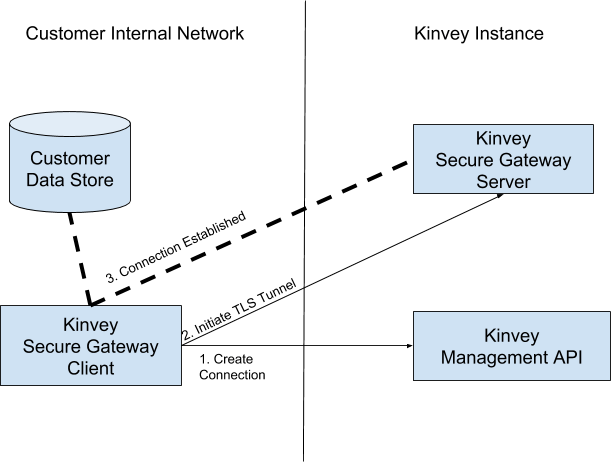Connecting to Data Sources with Kinvey Secure Gateway

Sometimes, your data sources may reside on infrastructure that’s not directly exposed to the internet, which can result in all sorts of challenges. Kinvey’s Secure Gateway makes connecting to these data sources much easier.
Kinvey Services enable developers to connect to external data and auth systems. For example, one could create a service to connect to a Microsoft SQL Server database, authenticate against ADFS or implement a piece of logic that orchestrates data from three different REST endpoints. The Kinvey platform comes with the “RAPID” feature: no-code, configuration-based modules to connect many such external systems. To learn more about RAPID, check out this article.
A big challenge that many of our customers face in adopting RapidServices is that their data sources reside on infrastructure that’s not directly exposed to the internet. As a result, they cannot connect to these data sources from their Kinvey backend. MMaking such systems available to their apps involves making firewall configuration changes, VPN setup, IP while-listing etc., which are not always good options. For customers on our multi-tenant instance, these solutions are not available at all today.
Secure Gateway makes this process much easier and is available to all Kinvey Business and Enterprise customers.
Secure Gateway consists of two components:
- Secure Gateway Client: A command-line tool that customers can install in their internal network
- Secure Gateway Server: A Kinvey service that is running on gateway.kinvey.com
The client tool, once installed inside the customer’s firewall, opens a bidirectional, secure channel with the gateway server. A RAPID service can then be setup to transfer data through this secure channel.

So, how does it work? Let’s say your app needs to connect to a SharePoint instance sitting inside your company firewall. Here’s how you can use Secure Gateway to access it from Kinvey:
-
Install the Secure Gateway Client tool. From the command line, create a new connection to Kinvey.
-
Start a secure connection by providing host and port information of your data source—in this case, your SharePoint instance. This creates a secure tunnel between Secure Gateway Server and your data source.
-
The Gateway Client tells you which port number of the Gateway Server is used for the tunnel. You then use this port number information to configure your service in the Kinvey console.
Kinvey Secure Gateway is currently available for trial. We’d love to have developers try it and share their experience with us. If you’re interested in getting access to Kinvey Secure Gateway, get in touch!

Tejas Ranade
Tejas is a Director of Software Engineering at Progress. He leads the team responsible for Kinvey SDKs, which enable developers to write rich, fast, modern apps on a wide variety of client platforms. He has helped build products in the mobile and web platform space for the past 10 years. You can find him on Twitter and GitHub.
